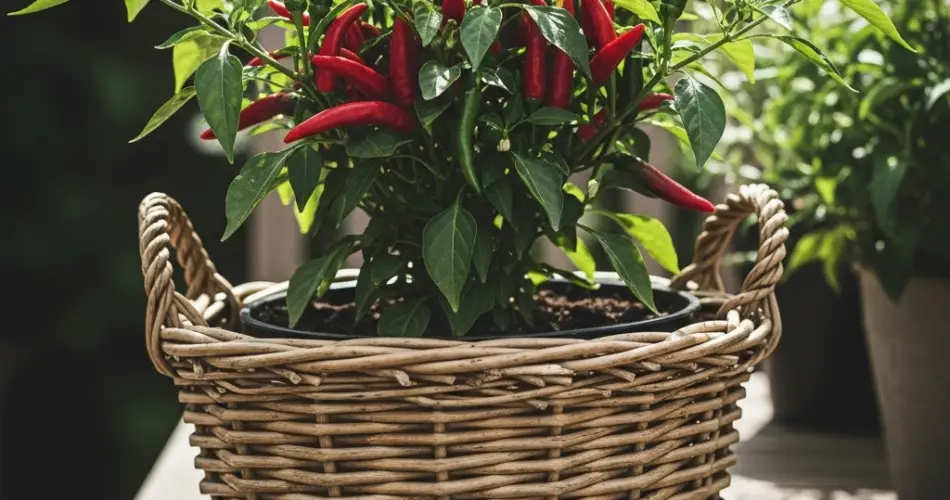Chili peppers are among the most rewarding plants for home gardeners. They add spice, flavor, and nutrition to a variety of dishes and can thrive in small spaces, making them ideal for compact gardening. Basket gardening offers a practical and attractive solution for growing chili peppers, especially in urban settings or on balconies and patios. By using baskets, gardeners can control soil quality, drainage, and sunlight exposure, while also enjoying easier harvesting and a steady supply of fresh chilies throughout the season.
Why Basket Gardening Works for Chilies
Chili peppers are compact plants with moderate root systems, which makes them perfect candidates for container gardening. Baskets offer several advantages:
-
Space Efficiency – Ideal for small urban spaces where traditional garden beds are unavailable.
-
Mobility – Baskets can be moved to follow sunlight or protect plants from harsh weather.
-
Improved Drainage – Woven or lined baskets allow excess water to escape, preventing root rot.
-
Ease of Harvesting – Fruit is easily accessible, reducing the risk of damaging stems or leaves during harvest.
-
Aesthetic Appeal – Baskets enhance the visual appeal of your garden while providing productive growth.
Choosing the Right Basket
For chili peppers, choose a basket at least 10–12 inches deep with a diameter of 12–16 inches per plant. Adequate depth allows roots to grow freely, while a wider basket ensures enough soil volume to retain moisture and nutrients. Ensure proper drainage holes to prevent waterlogging, which can harm root systems. For baskets with very open weaves, line them with breathable materials like burlap or coconut coir to hold the soil in place while still allowing water to drain. Sturdy construction is essential for safely handling the weight of soil and growing plants.
Preparing the Best Soil Mix
Chilies thrive in nutrient-rich, loose, well-draining soil. The right soil mix supports healthy root systems, encourages flowering, and produces abundant fruit. A recommended mix for basket-grown chilies includes:
-
40% Organic Compost – Supplies essential nutrients and improves soil structure.
-
30% Loamy Garden Soil – Adds minerals and stability.
-
20% Coconut Coir or Peat Moss – Retains moisture without compacting soil.
-
10% Perlite or Vermiculite – Enhances aeration and prevents waterlogging.
Thoroughly mix these ingredients to create a medium that is light, airy, and fertile, allowing chili roots to develop properly.
Planting Chilies in Baskets
Start with healthy seedlings or transplants for the best results. Plant one chili per basket to avoid overcrowding. Ensure the plant is slightly deeper than it was in its nursery container to support stability. Chilies can also be grown from seeds indoors before transplanting, giving gardeners a head start on the growing season. Proper spacing encourages airflow, reduces the risk of disease, and allows each plant to access nutrients effectively.
Sunlight and Watering Needs
Chilies require full sun for optimal growth, ideally 6–8 hours of direct sunlight per day. Place baskets in sunny locations, or supplement with grow lights if natural light is limited.
Consistent watering is critical. Keep the soil evenly moist but not waterlogged. Baskets dry out faster than garden beds, so check moisture levels frequently, particularly during hot or windy weather. Avoid wetting leaves to reduce the risk of fungal diseases.
Fertilization for Maximum Yield
While compost provides essential nutrients, additional feeding encourages strong growth and continuous fruiting. Use a balanced, water-soluble fertilizer or organic alternatives such as fish emulsion or seaweed extract every two to three weeks. Avoid over-fertilization with nitrogen, which can promote leafy growth over fruit production. Proper fertilization ensures healthy flowering and vibrant, flavorful chilies.
Harvesting Chilies
Chilies are ready to harvest once they reach their desired size and color. Regular picking encourages the plant to produce new flowers and fruit, ensuring continuous yields throughout the season. Handle chilies carefully during harvest to avoid bruising or damaging stems. Succession planting or staggered seedling introduction can help maintain a steady supply over time.
Managing Common Challenges
-
Pests – Aphids, spider mites, and pepper weevils can affect plant health. Use organic sprays or companion planting to deter pests.
-
Diseases – Fungal infections like powdery mildew may appear. Maintain proper spacing, good airflow, and avoid overhead watering.
-
Poor Fruit Development – Often caused by insufficient sunlight, nutrient deficiency, or irregular watering. Adjust care practices to promote optimal growth.
Conclusion
Basket gardening is an effective and rewarding way to grow chili peppers in small spaces. By selecting suitable baskets, preparing nutrient-rich soil, providing consistent watering and sunlight, and practicing proper fertilization, gardeners can enjoy continuous chili harvests throughout the season. Compact basket gardens transform balconies, patios, or urban nooks into productive green spaces, offering the satisfaction of cultivating fresh, flavorful chilies at home. With careful attention and regular care, basket-grown chilies provide a convenient, efficient, and vibrant addition to any small-space garden.



